Most Industrial Ethernet networks can provide hard real-time communication for multi-axis, synchronized motion control. But each one uses its own methods for time synchronization and data transmission to guarantee cycle times, latency, and jitter, making these networks incompatible with one another.
Time-sensitive networking (TSN) sets out to solve the network compatibility problem by providing standard methods for time synchronization and traffic management, allowing deterministic communication over standard Ethernet networks. It will also enable the “convergence of IT and OT” by making it possible to manage non-time-critical informational data (diagnostic and statistical data, for example) and time-critical operational data (motion control and safety commands, for example) on the same network without compromising quality of service (QoS).
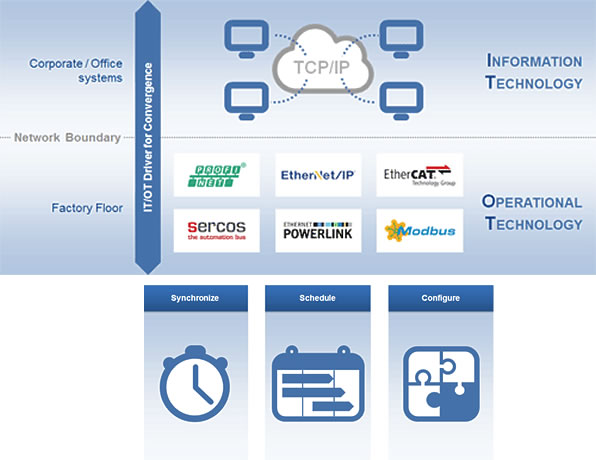
Image credit: Renesas
It’s important to note that time-sensitive networking is not a single technology – it’s a set of standards, maintained by the IEEE 802.1 task group, that defines the mechanisms for time-sensitive transmission of data.
Industrial Ethernet networks are based on the physical layer of Ethernet, but add proprietary protocols at other layers, including layer 2 (the data link layer), to achieve real-time communication. Time-sensitive networking standardizes layer 2 so different networking protocols can provide deterministic communication while sharing the same infrastructure. To do this, TSN handles three main functions: synchronizing all the clocks on the network, scheduling the most important traffic, and “shaping” the remaining traffic to achieve the desired traffic patterns.
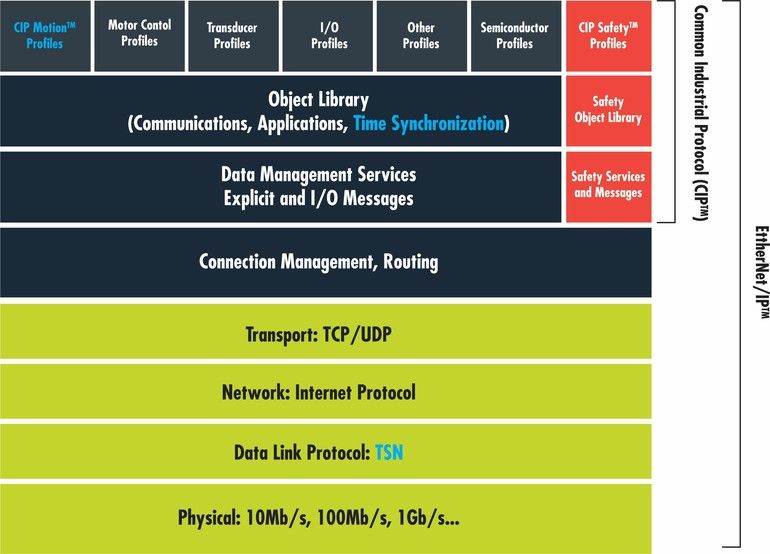
Image credit: ODVA
Synchronization
For hard real-time communication, each piece of equipment on the network must have the same understanding of time — that is, every device must be highly synchronized. TSN achieves this through the IEEE 1588 PTP (Precision Time Protocol). Note that some IE networks, such as EtherNet/IP and PROFINET, already use IEEE 1588 PTP for time synchronization. Most TSN networks will use a subset of IEEE 1588, referred to as IEEE 802.1AS or IEEE 802.1ASRev, for synchronization, although other subsets of IEEE 1588 are also possible solutions for TSN, depending on the specific application requirements. However, all devices on the network must use the same synchronization method.
Scheduling
For traffic scheduling, TSN uses the time-aware scheduler of IEEE 802.1Qbv, which allows the configuration of time slices on the network to serve different types of traffic. (This process is often referred to as TDMA — time division multiple access.) Each time segment, or slice, is assigned to a different traffic class, or priority. With time synchronization among all the network devices, each device knows precisely when each traffic class should be transmitted and processed and can hold other traffic as needed to ensure bandwidth is available for time-critical data. This method of time synchronization and traffic scheduling ensures the network can provide deterministic communication when needed.
Shaping
Shaping is the process of managing traffic for soft real-time communication, or to achieve predefined traffic patterns. There are a number of mechanisms in time-sensitive networking that facilitate traffic shaping based on the specific traffic requirements, and these shaping mechanisms can be combined within the same network. The combination of traffic shaping mechanisms and the time-aware scheduler enables different data types — hard real-time, soft real-time, and background data — to coexist on the same network.
Time-sensitive network is an evolving set of standards, and a joint IEC-IEEE standard is being developed to define the TSN profiles for industrial automation. This joint standard, known as IEC/IEEE 60802: TSN Profile for Industrial Automation (TSN-IA), will ensure compatibility among the various Industrial Ethernet protocols, allowing them to be used on the same network. The first official version of IEC/IEEE 60802 is expected in 2022.

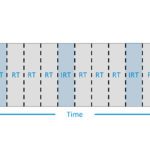
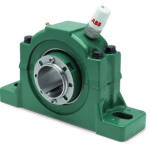

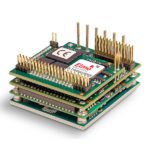
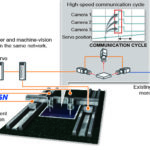

Leave a Reply
You must be logged in to post a comment.